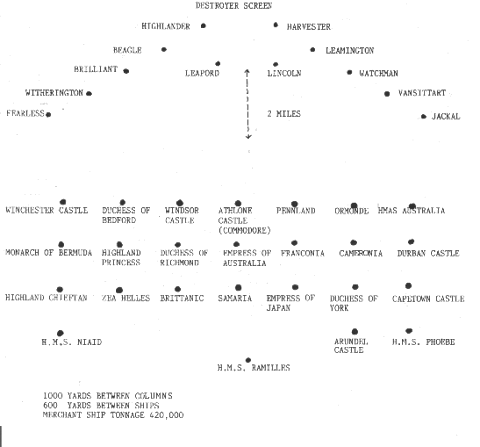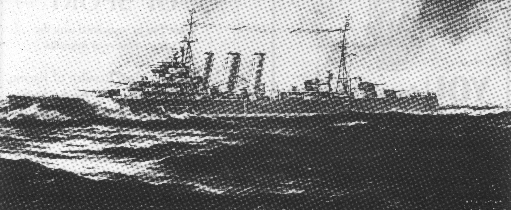|
HMAS Australia in the Atlantic
In January of 1941, I was serving in the County Class Cruiser HMAS Australia, having joined the ship in September 1939 at the outbreak of war. We had been operating in the Atlantic since July 1940. On Monday the 6th. of January 1941 we undocked from the Canada Graving Dock at Liverpool, having had a new port outer propellor fitted. The weather was extremely cold, and an influenza epidemic was sweeping through the ship's company. The next day we sailed with a convoy, anchoring in Moelfre Bay off the North East of the Island of Anglesey, Wales. Whilst at anchor, Destroyers maintained a continual anti-submarine sweep and RAF Hurricane aircraft kept up a constant air patrol to deter any enemy aircraft attack. The Cruiser Niaid joined us on Wednesday, and we refuelled the Destroyers Harvester and Highlander from astern. At 2100 ( 9 PM ) on Friday the 10th. of January we weighed anchor, took up station astern of the port column of the convoy and proceeded to Belfast Lough where we anchored the next morning. Sunday the 12th. we weighed and sheperding our convoy into formation, sailed for the Clyde in Scotland, there to be joined by the largest convoy ever to leave the British Isles, our convoy ships totalling 420,000 tons.
Off we went to the west, until reaching Longitude 24 degrees West, when all ships turned south. On the morning of the 15th. of January, four of our Destroyer escort left us, and later that day, Niaid and Phoebe, with CapeTown Castle and Duchess of Bermuda all parted company. We were joined by the very old Cruiser Emerald, and by the next day all the Destroyer escort had gone, to be followed on the 17th. with the departure of the Battleship Ramilles with Duchess of York. (in early 1940, Ramilles had been in Sydney, and Prince Philip was then a Midshipman in her, during a visit to that ship, I had met the Prince.) Up to this stage of our voyage, we had enjoyed the company of a most formidible escort, now it had all gone. Now only with Emerald and Australia to protect them, I am sure our large convoy of Merchant ships suddenly felt quite naked. We had passed through the dangerous submarine infested waters without any attack developing, it appears that providing one has a strong escort, particularly including numbers of the Greyhounds of the sea, Destroyers, that it acts as a sufficient deterrent. Britannic dropped out of the convoy, a broken lubricating oil line being the cause, Australia now circled around her until repairs could be effected and she could regain her convoy place. No one enjoys such a situation, leave a lame duck on their own, and immediately it becomes a possible target for any lurking U-Boat, but, protection comes at a price, the rest of the convoy is suddenly bereft of its major asset, Australia. It is left with an old, less gunned, and slower light Cruiser to hold the fort, and everyone keeps their fingers crossed, hoping, hoping no attack is forthcoming, in the end, we get away with it. Once more our convoy is a compact unit with Britannic a part of the main body. On Sunday the 18th. of January, it was learned that the tanker British Union has been sunk by a Raider, only 200 miles south of our position. The Armed Merchant Cruiser Arawa, in the vicinity, has picked up one of the tanker's boats, and is searching for other survivors. Monday the 20th. found us joined by Corvettes Aspidel, and Calendula, together with Velox, a Destroyer, they will provide an anti-submarine screen. In the afternoon the Merchantman, Clan Buchanan was sighted and identified. The method used for identification is: Australia challenges with flag signals N. N. J. meaning, what are your signal letters? We now look up their secret signal letters, consisting of a four letter group. The challenging warship sends back the two centre letters, and the challenged ship should respond with the two outer letters. If this proceedure goes according to plan, then identification is correct and completed. If the challenged vessel is unable to signal the correct two outer letters, she is then treated as a suspected enemy vessel, and appropriate action would be ordered by the Captain of the warship. With our flock, we continue towards the bulge that is West Africa, and it is estimated we will arrive at Freetown by next Saturday the 25th. of January. Two more ships joined the close screen, Clematis, and the Destroyer Vidette. By the 27th. the convoy had cleared Freetown en route to the Cape of Good Hope and Capetown, half of the convoy now parted company to enter into Capetown. Australia continued with the other half, setting course for Durban on the east coast of South Africa. Sunday the 9th. of February dawned, it happens to be my 19th. birthday, still at sea, and a long long way from home. Finally, we shepherd our segment of the convoy into Durban harbour, its the 16th. of February, our long journey, taking 5 weeks, is over, all the ships that commenced this voyage have arrived safely at their destination, our job is done. Again the expression "The speed of the convoy is the speed of the slowest ship." has well and truly been proven.
|


